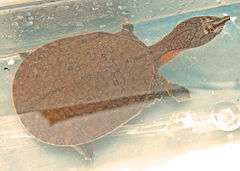Smooth softshell turtle
| Smooth softshell turtle | |
|---|---|
| Scientific classification | |
| Kingdom: | Animalia |
| Phylum: | Chordata |
| Subphylum: | Vertebrata |
| Class: | Reptilia |
| Order: | Testudines |
| Suborder: | Cryptodira |
| Family: | Trionychidae |
| Subfamily: | Trionychinae |
| Genus: | Apalone |
| Species: | A. mutica |
| Binomial name | |
| Apalone mutica (Lesueur, 1827)[2] | |
| Synonyms[3] | |
| |
The smooth softshell turtle (Apalone mutica) is a species of softshell turtle of the family Trionychidae. The species is endemic to North America.
Geographic range
A. mutica lives mainly in the Mississippi River drainage, including the Ohio River and the lower Allegheny River.
Description
The smooth softshell turtle is usually brown or olive-colored, often with darker dots or dashes. The shell of the turtle is leathery and flexible. Many individuals, mostly including young turtles, may have a yellow ring around the outermost part of the shell. However, this is also true with other species of softshell. Apalone mutica is the only softshell without ridges in the nostrils.[4] Females are 18–35.6 cm (7.1–14.0 in) in carapace length; males, 12.5–17.8 cm (4.9–7.0 in).
Diet
Typical foods of A. mutica include various macroinvertebrates such as aquatic insects, crayfish, and occasionally fish.[5]
Reproduction
From May to July, adult females of A. mutica lay clutches of 3 to 28 eggs not more than 100 m (330 ft) from water in sandy areas.[6]
Subspecies
Two subspecies are recognized, including the nominotypical subspecies.[7]
Nota bene: A trinomial authority in parentheses indicates that the subspecies was originally described in a genus other than Apalone.
Sympatric species
Apalone mutica is sympatric with the spiny softshell turtle (Apalone spinifera) over much of its range.[8]
References
- ↑ Tortoise & Freshwater Turtle Specialist Group (1996). Apalone mutica. In: IUCN 2013. IUCN Red List of Threatened Species. Version 2013.2.
- ↑ "Apalone mutica ". Integrated Taxonomic Information System (ITIS). ITIS.gov
- ↑ Fritz, Uwe; Havaš, Peter (2007). "Checklist of Chelonians of the World". Vertebrate Zoology. 57 (2): 306. ISSN 1864-5755. Archived from the original (PDF) on 2010-12-17. Retrieved 29 May 2012.
- ↑ Conant R. 1975. A Field Guide to Reptiles and Amphibians of Eastern and Central North America, Second Edition. Boston: Houghton Mifflin Company. xviii +429 pp. + Plates 1-48. (Trionyx muticus, pp. 77-78 + Plates 6, 12 + Figure 52, opposite Plate 12 + Map 33).
- ↑ "Apalone mutica mutica ". Ohio Department of Natural Resources. ohiodnr.gov
- ↑ DNr.wi.gov Archived June 16, 2010, at the Wayback Machine.
- ↑ "Apalone mutica ". The Reptile Database. www.reptile-database.org.
- ↑ Williams TA, Christiansen JL. 1981. "The Niches of Two Sympatric Turtles, Trionyx muticus and Trionyx spiniferus, in Iowa". Journal of Herpetology 15 (3): 303-308. JSTOR.org
Further reading
- Behler JL, King FW. 1979. The Audubon Society Field Guide to North American Reptiles and Amphibians. New York: Alfred A. Knopf. 743 pp. ISBN 0-394-50824-6. (Trionyx muticus, pp. 484–485 + Plates 268, 269).
- Boulenger GA. 1889. Catalogue of the Chelonians, Rhynchocephalians, and Crocodiles in the British Museum (Natural History). New Edition. London: Trustees of the British Museum (Natural History). (Taylor and Francis, printers). x + 311 pp. + Plates I-V. (Trionyx muticus, pp. 260–262, Figure 68).
- Lesueur CA. 1827. "Note sur deux espèces de tortues, du genre Trionyx de M[onsieur]. Geoffroy-Saint-Hilaire ". Mémoires du Muséum d'Histoire Naturelle, Paris 15: 257-268 + Plates 6-7. (Trionyx muticus, new species, pp. 263–266 + Plate 7). (in French).
- Smith HM, Brodie ED Jr. 1982. Reptiles of North America: A Guide to Field Identification. New York: Golden Press. 240 pp. ISBN 0-307-13666-3. (Trionyx muticus, pp. 32–33).

